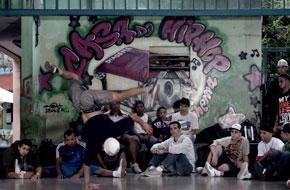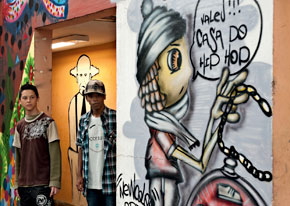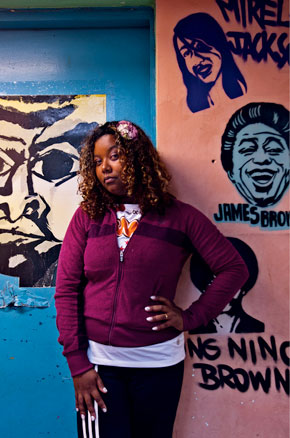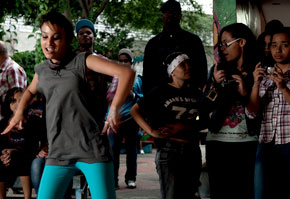
léo ramosA group of youths attending the presentation of a dancer at Casa do Hip-Hop, in Diadema, last monthléo ramos
Including contemporary popular culture in the curriculum of public schools might be the key for some of the structural problems of the Brazilian educational system, as professor Mônica do Amaral tries to show in her research on public policies, Rappers, os novos mensageiros urbanos da diáspora afro-brasileira na periferia de São Paulo: a contestação estético-musical que emancipa e educa [Rappers, the new urban messengers of the Afro-Brazilian Diaspora on the outskirts of São Paulo city: the esthetic-musical protest that emancipates and educates], conducted at the School of Education of the University of São Paulo (USP) with FAPESP support.
Her theoretical argument is based on activities conducted, first, at the José Alcântara Machado Municipal School of Fundamental Education in south side São Paulo city, and then at the NGO Casa do Zezinho, where she still coordinates workshops. Mônica plans to take the results of her research to the bureaus connected to the educational network of São Paulo state and São Paulo city.
The project involves a team of educators coordinated by her and aims to review the methodological basis of basic and fundamental education based on conducting art workshops, where the objective is to articulate music, dance, poetry and drawing with literacy. The hip-hop culture takes on a fundamental position in this process, although older popular cultures are also included. Initially, the activities conducted along with the teachers of the José Alcântara Machado School were based on an analysis of the cultural and social make-up of the community that they served.
The region is part of the south side of the city, alongside the Morumbi district, between two shantytowns (Jardim Panorama and Real Parque). Its earliest inhabitants were migrants from Pernambuco state that came to São Paulo city in the 1950s. They came from an area where, in the colonial past, there had been a policy of forced establishment of villages with peasants, former slaves and native Indians. Many were fleeing from extreme poverty and ended up as building workers during the construction of the Morumbi stadium.

léo ramosThe event’s audience: gathered to discuss the Revolt of the Malês and Afro-Brazilian subjects along with lots of dancing and graffitiléo ramos
The research on the origins of the community turned into the basis for three master’s degrees dissertations and one doctoral thesis, which is still under way, in addition to the post-doctorate (livre-docência) thesis called A trama e a urdidura entre as culturas juvenis e a cultura escolar: a “eróptica” como método de pesquisa e de ruptura de campo[The warp and weft of the youth culture and the school culture: “eroptica” as a method of research and of field rupture]. This work points out that the use of traditional European teaching methods did not work efficiently in the impoverished outskirts of São Paulo city. Furthermore, it could even help to make extreme poverty in the Northeast of Brazil worse.
The “decline of the authority of the teacher,” an expression employed by Mônica, in reference to the ideas of the German philosopher Hannah Arendt, is the central issue of the debate. “That traditional authority, whether stricter or more liberal, fell by the wayside a long time ago. However, if we listen to the life story of these children and of their families, if we value their culture, we have the conditions needed to reestablish the teacher’s authority,” she states.
To build this bridge, the project proposes, in its second stage, which is under way at Casa do Zezinho, to articulate the educational process with an understanding of these roots and with the production of works of art that might unravel the reality experienced by the students, besides encouraging them to think about it. The languages connected with the hip-hop movement, such as rap and funk, thanks to their reach among young people, gain more strength.
The basis of the project consists of workshops. The educators teach the participants how to make music, write lyrics for tunes and draw. During the exercises, they observe the students’ behavior and afterwards, the results. They then produce reports in which they describe the events experienced both by the students and by themselves.
According to Maria Cecilia Cortez, a professor of Education History and Philosophy at USP, Mônica “involved the teachers and opened their eyes to cultural manifestations. Many were blind and lacked willingness or time. They had become hardened as a result of their habits.”
Although articulating education and art is hardly a novel approach, Cortez states that the experiences of the last few years remained isolated at NGOs and did not take root in middle and fundamental schooling. “They are specific works, that might have been extended,” the researcher advocates. “When the school doesn’t take these cultures into account, when it only offers the European educational tradition, it presents a partial view and doesn’t perform what Brazilian culture did in the past and continues to do: integrate the different perceptions of indigenous or black origins with daily life.”
The management of the Brazilian schools remained “deaf” to these roots, Cortez continues, and that is why they slipped into a state of inertia. “You see that both the students and the teachers have no interest in their bureaucratic activities. They don’t see themselves as individuals who can participate and develop,” he concludes.

léo ramosDancer Drica and graffiti by Nino Brown, a precursor of hip-hop in Brazilléo ramos
Likewise, the opportunities to understand the students in greater depth are also wasted. It is not unusual for art workshops to offer rich material about life in the city outskirts. The classes for writing song lyrics, for example, besides functioning as an “assertion of identity,” as Mônica says, enable teachers to learn about more about the students involved.
Exchanges
To exemplify the interchange among the artistic productions of boys and girls with a vocation for what Mônica calls “chronicles,” the researcher recites verses by a boy called Renan, printed in a leaflet produced in class: “I was an urchin, a black boy from the shantytown/My father’s a layabout who’s always watching soap operas/Afraid of dwarfs, he listens to Belchior/ And here´s me, learning all that’s bad out in the streets.” “See how sharp they are,” says Mônica .
The same leaflet is illustrated with drawings. Among these, what drew the attention of the researcher was the number of pictures representing walls. “There were a large number of them and they symbolized what was keeping them apart from the rest of a city that is well served by public services.”
The context of the creations, even in the field of language, is also debated in class. “We talked about what ruptures these sorts of lyrics or what the broken rhythms allow. And we didn’t only work with electronic media, but also with Afro-Indigenous drums, wind instruments, and rattles, for the students to start developing a new basis,” she tells us.
According to Mônica, there are similar experiments in US schools. In January of this year, she visited Hip-Hop Education, a study center that belongs to the NYU Steinhardt School of Culture, Education and Human Development in New York. Complementing their school curriculum, rappers and graffiti artists are invited to hold art and education workshops.
There is a parallel here with São Paulo’s reality. In major US cities, school evasion and student disinterest are also problems for the management of the public educational network. “Both there and over here, it is important to go for something that motivates them, that strengthens their identify and respect in relation to society. Through rap, they impose themselves,” says the researcher. “When they can show their potential, this means the world to them, and that is how their artistic, poetic and esthetic work becomes more sophisticated,” she advocates.
Workshops
Mônica ’s research is also backed by testimonies. The journalists Djalma Leite de Campos took charge of recording interviews on video with rappers and funk artists and the content is shown in the classroom. “This has fueled our workshops. Some testimonies show what led these artists to become rappers. Others explain how to build bases and rhythms.”

léo ramosThe first Hip-Hop in Action in 2012, at Casa do Hip-Hop, brought students together to dance and discuss societyléo ramos
Milton Santos was one of the interviewed rappers and his testimony was recorded at the Moinho shantytown, following an episode of arson in the community. In this interview, he explained that he had lived in Vila Madalena and in other districts of the city’s expanded central area, but that he had decided to return to the area he had grown up in, as he did not want to lose contact with the reality that had inspired his work.
Mônica recounts that the proposal to work with rap and with funk, at first, generated resistance within schools. “The reaction was terrible because of a morality that condemned rap for its violent language and funk for the eroticization of women’s body and for its sensual dances. This affected the teachers,” the researcher tells us. According to her, the analyses that formed the basis of these refusals are superficial: Mônica says that funk advocates women’s right to talk about their own sensuality, while rap copies violence, crime and the struggles with the police, putting the spectator in the center of action, to then generate awareness about the violence that reigns on the outskirts of the large cities.
“It isn’t a pure imitation of violence and the discourse of crime. This is their language. Adolescents and youths first identify with the situation and afterward become aware of what that stands for in their lives.”
Now, in the second year of her research, Mônica’s team also has the help of a geography teacher, Lourdes Carril, and of Claudia Florindo, from the field of literacy. “We often find semi-illiterate youths who managed to create lyrics, having been motivated by the workshops. Boys that couldn’t read and others who could ended up producing things together,” she tells us.
Her bet on the hip-hop movement is based on yet another element. The United States, France, South Africa, Portugal and many other countries are part of a global movement around this esthetic genre. Like the Rationalists, rappers are chroniclers, as what often goes unpublished in the newspapers is stated in their lyrics. “That is why the rap and the hip-hop culture earned respect. It is an esthetic movement that works with rhythms from the past and that combines this with everything that is most up-to-date in terms of technique and media,” the researcher explains. Though an approximation with the alienating mass media occurs first, what comes next is a critical withdrawal,” she analyzes.
The research concludes that the hip-hop culture offers tools for a review of the educational system, but there is another problem that remains rigidly solid, often hindering learning. The team coordinated by Mônica faced a number of difficulties, mainly because some of the children and adolescents still suffer from violence and oppression in the streets or in their domestic environment.
There was the case of a youth who started to cry compulsively during one of the workshops. Or of the students who stopped paying attention. Or one student who lost his concentration because his friends had been murdered.
The teachers’ wages are an altogether different chapter of this story.
The Project
Rappers, the new urban messengers of the Afro-Brazilian Diaspora on the outskirts of São Paulo city: the esthetic and musical contestation that emancipates and educates (nº 2010/52002-9); Modality Program of Research into Public Policies; Coordinator Mônica G. Teixeira do Amaral – USP; Investment R$ 54,814.86